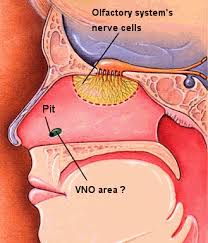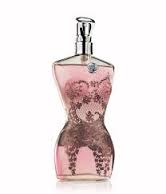Human pheromones

A pheromone is a chemical produced by an animal, which changes the behavior of another animal of the same species, including insects. Pheromones are ecto-hormones, that is, they act outside the body of the individual that secretes them, impacting the behavior of another, whereas hormones impact the behavior of the same individual that secrets them. Most of non-human animal species use a specialized olfactory system to detect pheromones, called the vomero-nasal organ (VMO). It has been found that signals of pheromones can travel long distances. Experts say that the pheromone system of insects is much easier to understand than that of mammals, which do not have simple stereotyped behavior as insects. Plants emit pheromones as well, particularly when they are preyed upon. This leads to production of tannins by adjacent plants, making the plants less edible for the preying organism.
Many claim that humans also produce pheromones. However, the studies about it are very limited so the evidence about the existence of human pheromones is little.

Human pheromones -
In view of the roles of different pheromones in animals, including insects and plants, researchers have shown great interest in finding the existence of human pheromones and their role. The scientists have long debated if love or at least sexual attraction is triggered by pheromones in humans. Still, after decades of research, the story in humans is not quite so clear. Some scientists believe that a lot of human communication is influenced by chemo- signals. For example, a releaser pheromone guides a newborn baby to the mother’s breast by scent. Newborns will move in the direction of the odor source. Research published last year pointed to secretions from the areolar gland "bumps" on mother's nipples as the source of the behavior-modifying, odorous molecules that cue a baby to find its food source.
The strongest evidence for pheromone signaling between humans had been revealed by Dr. Martha McKlintock, who discovered in 1998 that the menstrual cycles of women living together tend to synchronize because of the chemical messages released in their sweat. But some scientists have spurned the theory of menstrual synchrony by giving their valid reasons against it.
The scientists, led by Dr. Ivanka Savic of the Karolinska Institute, found that the hormone-like smells "turn on" the brain's hypothalamus, which is normally not activated by regular odors. Women's hypothalami are activated, when they smell the chemical similar to testosterone but not to the estrogen-like substance, whereas men's hypothalami have the opposite response. They are turned on only by the estrogen-like chemical but not the testosterone-like one. There is also sexual disparity between the specific sub-regions of hypothalamus that are activated.
According to the proponents of the concept of human pheromones, human pheromone levels peak around 18 years and then slowly decline throughout our life. That is why we are always aware of teenagers and youngsters in a room. By age 40, your pheromone signals no longer excite others, when you enter a room as they did when you were 18. The declining interest of others as we age may be more due to pheromone declines than physical changes in our bodies because smells activate emotions. Smells and our response to them are extremely important to proper body functioning. A very significant part of the human genome - about 1,500 genes of our 30,000 human genes - is used to code the receptors of smell.
Two anatomically distinct organs respond to smell, the olfactory system located in the upper part of the nasal cavity, and the vomero-nasal organ (VMO) in the nasal septum. Smells activate nerves in the vomero-nasal organ that act directly on the brain's emotional control areas. The nerves that respond to smell are wired directly into the brain and the stimuli are sent pure and unmodified to the limbic center of the brain. The limbic system is where emotional responses are concentrated. When various areas of the limbic system are activated, a person feels intense emotions. Why we love someone more is how they smell to the limbic system than what we consciously think.
While many pheromones have distinct smells, you may be influenced by a small amount of a pheromone that does not create a conscious odor. Studies of brain EEG patterns of behavioral evidence have also come to the same conclusion: that we can be strongly affected by pheromones that we are not even conscious of smelling.
Types of human pheromones –
Human pheromones are made up of different types of compounds, which are basically derived from hormones and fatty acids. Very few of them are only found in either men or women; in most cases, most of them are present in both but in different ratios. Commonly known human pheromones are enlisted below –
Androstenone - This pheromone, found in both men and women, is predominantly known of as a male pheromone. This is because it typically creates a dominant, intimidating or aggressive aura. Since aggressiveness is often associated with sex and good mate choice, this pheromone can create a sexual vibe and increase sexual tension. Certain elements of androstenone have shown the ability to arouse sexual feelings. Members of the opposite sex are mostly attracted to males with a dominant aura. This is one of the hormones associated with puberty in humans.
Androstenol - There are two types of this compound - the alpha and beta isomers, each producing slightly different effects. The alpha and beta have nothing to do with the pheromone projecting an alpha aura. Both seem to cause chattiness and friendliness.
Androsterone – Males having higher levels of androsterone are more masculine or dominant but without the aggression of androstenone. This pheromone also creates an aura of safety, protection and reliability, normally associated with a more peaceful alpha male. Androsterone also provides the respect of androstenone without the possible negative connotations of the aggressive nature of androstenone.
Androstadiennone (A1) – This pheromone is supposed to have a specific effect on the brain activity of women. It affects areas of the brain associated with attention and social cognition. Commonly known as A1, it can elevate a woman’s mood, and even alleviate PMS stress! It has been known to increase intimacy and comfort. And it can also increase caring feelings. It has been called the “love pheromone” because of the nature of the feelings it induces in women, and also because of its usefulness in more cozy relationship situations.
Copulins – They are exclusively female pheromones. There are secreted into the vagina at the optimum ratios during ovulation with the aim of encouraging men to desire to copulate. Astrid Jutte study shows that they are capable of increasing testosterone levels in men by 150%. This increase in testosterone may cause feelings of arousal in men if a woman is present. Once a man smells copulins on a woman, she is deemed to appear to be more attractive. Typical reactions from copulins will be consistent with male indications of interest.
Estratetraenol – This is supposed to be female equivalent of androstadiennone (A1). It may also contain mood elevating effects in men.
According to most research, humans haven’t yet found a way to consciously send out pheromones as signals to attract mates. But besides widely misunderstood effects of pheromones in human beings, use of pheromones is extensively made in perfumes as sexual attractant.

Use of pheromones in perfumes –
Much ado has been created in the media about the role of pheromones as a sexual attractant. And perfume industry takes its advantage in using pheromones in perfumes and promoting them extensively. More and more pheromone-infused fragrances and colognes are popping up on shelves and often they’re marketed with some big claims.
Non-human mammalian pheromones are commonly used as perfumery ingredients. The actual purpose for using these compounds is as a fixative or carrier for the odor effects of the other ingredients as well as a contributor, in part, to the over-all scent of the perfume. While a scent may elicit a positive pleasant response, this should not be confused with a pheromone response. The attractant effect of perfumes is principally related to the effect of the pleasant scent.
It’s worth noting that many popular fragrance products, including scents from Chanel and Gucci, have been formulated with additives rich in animal pheromones - ambergris, musk - for years. It’s simply that ambergris and musk smell pleasant to us that attract us to those fragrances. Most of the perfumes contain these ingredients, which are generally produced synthetically today because it is cost effective.
Human pheromone: a myth or reality –
After decades of research, scientists have not been able to establish facts about the existence of human pheromones and their role in human beings. Many scientists are unwilling to accept the pheromone concept in humans. Richard Doty argues that the concept of pheromone is too simple for mammalian chemonsensory systems, failing to take into account learning and the context-dependence of chemosensation. In his book – The great pheromone myth - he is especially critical of human pheromones, arguing that not only are there no definitive studies finding human pheromones, but that humans lack a functional vomero-nasal organ (VNO) to detect pheromones.
He argues that there are serious problems with the application of concept of pheromones to mammals. The functions of pheromones, as specific types of compounds, are to produce unlearned, reflexive and innate responses in recipients. He further argues that mammals respond to the chemical compounds that are typically combination of many, which act in complex social situations. And experience and learning are important how mammals respond to chemical stimuli. According to Richard Doty, “junk-science industry of pheromone-perfumes, pheromone-soaps, and pheromone cosmetics” arose from misunderstood research with mammals.
Although his views have been well received by the scientific community, some like Peter Brennan argue that Doty does not consider some of the more recent scientific research that conflicts with his views.
Conclusion –
A tug-of-war has been going on between the proponents and opponents of the concept of existence of human pheromones for quite some time. Many well structured studies are required to be undertaken to validate the presence of pheromone in humans before it can be decided, who emerges winner. If the proponents win, there will be a paradigm shift in the process of manufacture of perfumes from the art of perfumery to the science of perfumery.







